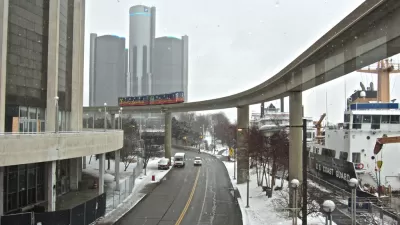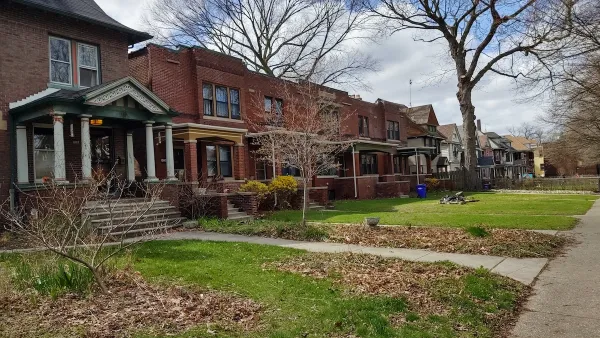A short guide to a few of Detroit's historic neighborhoods.

Last weekend, I was at the 24th Congress for the New Urbanism in Detroit. Near the end of the conference, I overheard someone saying: "I wish there was a guide to Detroit, like Lonely Planet or something." Even though I didn't see enough of Detroit to create a book-length guide, I think I saw enough for a blog post. So I thought I would write one.
I started off walking around downtown Detroit; downtown has apparently improved over the past few years, and seemed to me to be the most attractive part of the city. Although a few of the city’s historic office buildings are still unoccupied, many are now used either as offices or as residences, and others are clearly in the process of being rehabilitated. In addition, downtown has some interesting public spaces, most notably the Campus Martius park, which has a sandbox, a basketball court and other attractions. At the southern tip of downtown is the surprisingly blue Detroit River. On the negative side, the river is separated from the rest of downtown by Jefferson Avenue, a high-speed street (or stroad) with four lanes of traffic in each direction.
A few interesting neighborhoods are within walking distance (more or less) of downtown. The leafy Lafayette Park neighborhood, just east of downtown, is one of the better examples of mid-century "Towers in the Park" design; it includes both two-story townhouse units and high-rises designed by Mies Van Der Rohe. While mid-century construction is often unattractive, Lafayette Park's walkways and generous tree canopy actually make it seem parklike. On the negative side, I might be reluctant to live there if I lived in Detroit, because to get there from downtown, I walked through some blocks that seemed desolate even during the daytime.
Just northeast of downtown is an even more unusual area, Brush Park. This area is full of 19th-century Victorian mansions, only about a quarter of which survive. Because Brush Park deteriorated during the 20th century, much of the neighborhood is urban prairie—that is, some of the houses were destroyed, and their yards reverted to nature. But today, the neighborhood is being revitalized; some of the mansions are being rehabilitated, while once-empty blocks are filling up with new houses and condos. As a result, Brush Park is currently an interesting mix of progress and decay: some blocks are full of new houses, while others have a Victorian or two surrounded by prairie. I suspect that a decade or two from now, every inch of Brush Park will be inhabited. I wonder if the people who stay there till the 2030s will miss the old days of one or two houses per block.
A more conventional 19th-century neighborhood, Corktown, is about a 15 or 20 minute walk west of downtown. Corktown is dominated by small Victorian houses; my sense is that in 1900 it was a poorer area than Brush Park. Unlike Brush Park, it is mixed-use: our group did a Corktown pub crawl last week. On the negative side, the neighborhood’s main street, Michigan Avenue, is another of these huge streets that aren’t really much fun to cross, and the walk from downtown to Corktown involves some pretty desolate blocks. (I walked to Corktown before dark, but took a cab at night because those blocks gave me the willies.)
In addition to visiting areas within walking distance of downtown, I sampled local buses. I limited my urban bus use to the Woodward Avenue bus (bus 53), because the buses run every ten minutes during the day. By contrast, most Detroit buses seem to run much less frequently.
Woodward is another gigantic stroad, and is mostly bounded by poor areas. So if (unlike me) you are brave enough to explore lots of urban prairie, Woodward is as good a street as any to start with. But there are a few relatively prosperous areas off Woodward. Midtown Detroit, just north and west of Brush Park, includes a Whole Foods, a few new apartment buildings, most of the city’s museums, and Wayne State University. In addition, the more sterile New Center area north of Wayne State includes the Fisher Building (an art deco skyscraper/theatre) and numerous office buildings.
A few miles further north, just west of the 9300 block of Woodward, is the Boston-Edison historic district, full of 1920s mansions. (Henry Ford briefly lived in the neighborhood, at 140 Edison Avenue.) But unlike similar areas in more prosperous cities, Boston-Edison is not surrounded by walkable retail; instead, the retail near this area looks just like the rest of Woodward Avenue—that is, suburban and poor.
Still further north, at Seven Mile Road, is the Palmer Woods historic district—another wealthy 1920s area. Like Boston-Edison, Palmer Woods is not surrounded by walkable retail, and the area across Woodward from Palmer Woods looks quite distressed.
Ultimately, the Woodward Avenue bus terminates at a transit center at the city edge, where you can take buses to the suburbs (as I did one morning). The area has separate bus systems for the city and the suburbs; the Detroit Department of Transportation serves the city, and a separate agency called SMART serves the suburbs. The SMART bus I took (serving the suburb of Oak Park) runs every 45-60 minutes till about 10 PM. As a general matter,Detroit bus service seems roughly comparable to the much smaller area of Jacksonville,Florida (where I lived from 2006-11): bus routes serve a big chunk of suburbia, run into the evening but not until midnight, and tend to run every 30-60 minutes.

Planetizen Federal Action Tracker
A weekly monitor of how Trump’s orders and actions are impacting planners and planning in America.

Chicago’s Ghost Rails
Just beneath the surface of the modern city lie the remnants of its expansive early 20th-century streetcar system.

San Antonio and Austin are Fusing Into one Massive Megaregion
The region spanning the two central Texas cities is growing fast, posing challenges for local infrastructure and water supplies.

Since Zion's Shuttles Went Electric “The Smog is Gone”
Visitors to Zion National Park can enjoy the canyon via the nation’s first fully electric park shuttle system.

Trump Distributing DOT Safety Funds at 1/10 Rate of Biden
Funds for Safe Streets and other transportation safety and equity programs are being held up by administrative reviews and conflicts with the Trump administration’s priorities.

German Cities Subsidize Taxis for Women Amid Wave of Violence
Free or low-cost taxi rides can help women navigate cities more safely, but critics say the programs don't address the root causes of violence against women.
Urban Design for Planners 1: Software Tools
This six-course series explores essential urban design concepts using open source software and equips planners with the tools they need to participate fully in the urban design process.
Planning for Universal Design
Learn the tools for implementing Universal Design in planning regulations.
planning NEXT
Appalachian Highlands Housing Partners
Mpact (founded as Rail~Volution)
City of Camden Redevelopment Agency
City of Astoria
City of Portland
City of Laramie





























